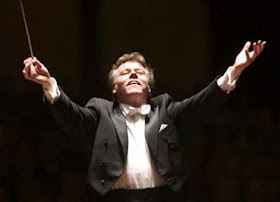 Mariss Jansons, conductor Sibelius, Violin Ccncerto | Rachmaninov, Symphony No. 2 |
Tchaikovsky Concerto Beethoven / Britten Bruch / Mendelssohn |
This was a performance that was sultry, almost oddly so, at its best in the smoky introduction to the first movement for example, its tense and dramatic opening supported by a hushed string section. The tone could be searing and throaty -- at least from our place closer to the stage (other
Rachmaninov, Symphony No. 2, Detroit Symphony Orchestra, L. Slatkin (released on January 26, 2010) Naxos 8.572458 | 60'43" |
If any orchestra and any conductor could make me do exactly that, however, it would be the Royal Concertgebouw and Mariss Jansons. The orchestra made what is probably the best Rachmaninov symphony cycle, with Vladimir Ashkenazy, if you do happen to be a fan, including the uncut version of the second symphony, which they also played here -- all fifty-odd minutes of glorious, eye-rolling treacle (perhaps some cuts were a good idea, after all?). The Largo introduction to the first movement seethed with anguish, until a lovely English horn solo swept us into the fast section, complete with carefully calibrated tidal swells of the entire ensemble. The scherzo was agitated, with a haunted middle section, the sounds of the military band echoed in the trio seeming to come right out of Berlioz.
Anne Midgette, A passionate Royal Concertgebouw with Janine Jansen, violin soloist (Washington Post, February 17) Tim Smith, Royal Concertgebouw Orchestra with Jansons, Jansen superb in DC visit (Baltimore Sun, February 16) Alex Baker, Concertgebouw! (Wellsung, February 15) Allan Kozinn, A Dutch Orchestra Plumbing the Depths (New York Times, February 18) |
The next orchestra invited to Washington by WPAS is the San Francisco Symphony, which will appear at the Kennedy Center Concert Hall next month (March 24, 8 pm) in a program of Tchaikovsky, Ravel, Liszt, and Kissine.
I am a fan of your blog but must disagree with this review. You came and what did you want, a life altering experience? The KCO offered excellent playing throughout the ensemble, heck, in DC I’d be happy if the back of the first violins are even paying attention. The orchestra has a sound the is second to none, they blend as an ensemble in a way that is unique, the oboe takes on timbres of the strings, and the horn seems to grow out of the wind colors. Even the crash cymbals were warm and lush to match legato passages. Some may have preferred a concert of heavier rep, but the Rachmaninov belongs to a class of “starter symphonies” that are very approachable to people without much exposure to classical music. It can’t be Mahler every night, sometimes lighter music is fine (just with variety please! I am bored with the same Tchaikovsky over and over again, paired with a concerto and modern overture) This concert was likely the finest orchestral playing in DC since the London Symphony was here last March.
ReplyDeleteThank you for reading, and thank you especially for making a comment. It is always helpful and satisfying to have one's views challenged!
ReplyDeleteI agree with all of your praises -- indeed, I had nothing but praise for the orchestra's sound. With all that talent, however, the concert just felt jejune -- not unpleasant at all, just not the sort of superlative evening one has come to expect from them.
It sounds like Allan Kozinn's impressions, in the New York Times, are right in line with mine. The best playing was in the Mahler (which we did not hear), the Sibelius was "puzzling," and the Rach2, an "unwieldy" and "sprawling" score, "remained a parade of appealing episodes rather than an exciting whole. The playing was beyond reproach, but even so, it barely hinted at what was to come with Mahler the next night."
ReplyDelete